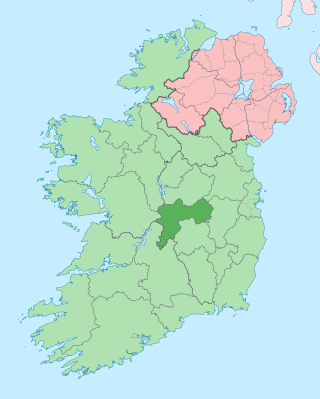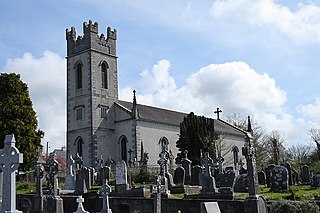
County Offaly is a county in Ireland. It is part of the Eastern and Midland Region and the province of Leinster. It is named after the ancient Kingdom of Uí Failghe. It was formerly known as King's County, in honour of Philip II of Spain. Offaly County Council is the local authority for the county. The county population was 82,668 at the 2022 census.

Tullamore is the county town of County Offaly in Ireland. It is on the Grand Canal, in the middle of the county, and is the fourth most populous town in the Midlands Region, with 15,598 inhabitants at the 2022 census.

Kilbeggan is a town in County Westmeath, Ireland. It is in the barony of Moycashel.

Durrow is a small rural village and townland in County Offaly, Ireland. Durrow is located on the N52 off the N6 road between Kilbeggan and Tullamore.

Clara is a town on the River Brosna in County Offaly, Ireland. It is the 10th largest town in the midlands of Ireland. The town had a population of 3,403 as of the 2022 census.

Shannonbridge is a village located on the River Shannon, at the junction of the R444 and R357 regional roads in County Offaly, Ireland. It lies within the townland of Raghra, at the borders of counties Offaly, Galway and Roscommon, with the majority of the population living east of the bridge in County Offaly. As of the 2016 census, the village had a population of 175. There are two housing estates within the village. Its location along Ireland's largest river and its proximity to Clonmacnoise have contributed to tourism being a key contributor to the local economy. The village is flanked by a Special Area of Conservation – the Shannon Callows. The physical environment consists of the River Shannon, callows, boglands and the Esker Riada. The village has one of the oldest bridges still in use over the River Shannon, completed in 1757.

Daingean, formerly Philipstown, named after King Philip II of Spain, is a small town in east County Offaly, Ireland. It is situated midway between the towns of Tullamore and Edenderry on the R402 regional road. The town of Daingean had a population, as of the 2022 census, of 1,223. It is the principal town of the Daingean Catholic Parish. The other main poles of this parish are Ballycommon, Kilclonfert and Cappincur.

Clonaslee is a village in north County Laois, Ireland, situated in the foothills of the Slieve Bloom Mountains on the R422 Mountmellick to Birr road. Clonaslee is approximately 100 km west of Dublin, and is close to the towns of Portlaoise and Tullamore.

Ballyboy or Ballaboy is a village in County Offaly, Ireland. It is about two kilometres east of Kilcormac.

Pollagh, also spelled Pullough, is a village in County Offaly, Ireland, located in the midlands of Ireland. It is a rural village on the Grand Canal and lies between Ferbane and Tullamore. Much of the surrounding area is bogland, and is used to produce fossil fuels such as peat turf. The River Brosna flows close to the village. The Grand Canal was used for transporting peat and bricks produced in the area. Pollagh benefited from the canal in earlier years when it brought investment and employment from Bord na Móna, and it is now a tourist attraction. Pollagh is also known for its church, including its bog oak altar and stained glass windows, designed by the Harry Clarke studios.

Killeigh is a village in County Offaly, Ireland. It is located around 8 kilometres (5 mi) south of the county town of Tullamore, on the N80 national secondary road; the Slieve Bloom Mountains lie a similar distance further south.
Killoughey, officially Killoughy and historically "Killaghy" or "Killahy", is a townland and civil parish south-west of Tullamore in County Offaly, Ireland.
Mountbolus is a small village in County Offaly, Ireland. It is in the parish of Killoughey situated at the foot of the Slieve Bloom Mountains, 13 km south-west of Tullamore.

The Offaly Way is a long-distance trail in County Offaly, Ireland. It is 37 kilometres long and begins in Cadamstown and ends at Lemanaghan, on the R436 road between the towns of Clara and Ferbane. It is typically completed in two days. It is designated as a National Waymarked Trail by the National Trails Office of the Irish Sports Council and is managed by Offaly County Council, Bord na Mona and the Offaly Integrated Development Company. The trail provides a link between the Slieve Bloom Way and the Grand Canal Way.
Rath is a hamlet in the south west area of County Offaly, Ireland. The hamlet is located midway between the towns of Birr and Kilcormac on a northeast-southwest country road. It is located in the parish of Eglish and Drumcullen which is in the Roman Catholic Diocese of Meath. The hamlet has a number of local amenities for the local population including a church, a national school, a local community centre and a local shop. Drumcullen GAA is the local GAA club and is located about half a kilometre to the south of the hamlet.
Firceall was an ancient Gaelic Irish territory which formed the most south - westerly part of the ancient Kingdom of Meath. O'Molloy was chieftain of the territory. Firceall itself comprised the ancient baronies of Ballycowan, Ballyboy and Eglish, which are located in modern day mid County Offaly extending from Durrow north of Tullamore to Eglish on the edge of Birr in an area which is some 25 miles in length by 5 miles in width. The name Firceall comes from the Irish words Fir Ceala meaning Men of the Churches.

Eglish, also called Fercale is a barony in County Offaly, Ireland.
The 2019 Offaly Senior Hurling Championship was the 121st staging of the Offaly Senior Hurling Championship since its establishment by the Offaly County Board in 1896. The championship began on 30 March 2019 and ended on 20 October 2019.
The 2020 Offaly Senior Hurling Championship was the 122nd staging of the Offaly Senior Hurling Championship since its establishment by the Offaly County Board in 1896. The beginning of the championship was postponed indefinitely due to the impact of the COVID-19 pandemic on Gaelic games. The championship eventually began on 31 July 2020 and, after being suspended once again, eventually ended on 14 August 2021.
The 2022 Offaly Senior Hurling Championship was the 124th staging of the Offaly Senior Hurling Championship since its establishment by the Offaly County Board in 1896. The group stage placings were confirmed on 28 May 2021. The championship ran from 24 June to 2 October 2022.
















